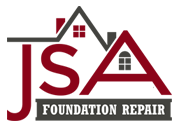Resistance Pier Method & Steel Push Pier
JSA Foundation Repair permanently restores foundations using the proven best methods such as hydraulic-driven steel push piers (resistance piers).
JSA Foundation Repair permanently restores foundations using the proven best methods such as hydraulic-driven steel push piers (resistance piers).
Our experts investigate whether faulty footing is the true source of a problem and provide you with the correct advice upfront. Many repair choices initially seem like a good value:
However, these are temporary fixes that eventually lead to more foundation issues.
In most cases of footing failure, JSA’s preferred remedies include:
Steel push piers offer incredible strength and endurance that can ensure the structural integrity of a foundation for the lifetime of a home or business.
Helical piers, or screw piles/anchors, are steel tubes fitted with plates that give them the appearance of oversized screws. The installation process is similar to inserting a wall screw using a screwdriver, but it’s on a larger scale and requires heavy-duty equipment.
The contractor measures the turning resistance, or torque, as a helical pier is mechanically driven into the ground until reaching load-bearing soil. Steel brackets are then attached, connecting the helical piers to the foundation.
If torque/kip measurements are calculated incorrectly, this leads to repeat visits from the contractor. Foundation backfill most often includes boulders, construction debris, and even large roots. Resistance piers press through improper backfill, but helical piers don’t usually succeed. For example, when a boulder or tree stump is mixed in with backfill, the helical pier reaches it and just spins on top of it. This installer must always return for adjustments.
In previous years, the lifting and leveling of settled concrete slabs was performed with a very unreliable process called mudjacking. Polyjacking, or PolyLevel foam injection, is a newer alternative, but it’s still only a short-term answer.
Mudjacking Method
In mudjacking (slab jacking, pressure grouting, slab leveling), a contractor drills many big holes in the concrete slab and pump large amounts of a muddy slurry or liquid concrete beneath it until voids are filled and the slab is raised to the desired height.
This process is messy, and the heavy mixture takes a long time to cure. Even worse, soil settlement will inevitably occur again within years or even months, and the mixture’s extra weight speeds up settlement.
PolyLevel Foam Injection Method
PolyLevel jacking requires fewer and smaller holes to be drilled into the concrete than mudjacking. A truck with a long hose is used to inject a chemical mixture in the holes. As the chemicals mix, they form a lightweight polyurethane foam that expands to fill cavities and lift the slab.
Unfortunately, it’s difficult to know when to stop the foam injection because the installer can’t see how much ground space has been filled. The foam can continue expanding past the desired amount. Soil around the foam can also erode again.
Contractors state in the contract that they are not responsible for any damages. The homeowner is now stuck with this problem while wasting money with a negative outcome.
There are two types of slab lift pier systems – push slab piers and helical slab piers. The method selected is based on the type of foundation issues, but they can be equally effective and involve a similar installation process.
Push Slab Piers
Helical Slab Piers
At this point of installation for either pier system, the concrete slab is lifted level. Grout is pumped beneath the slab at a low pressure, filling any voids. The holes around each pier are then filled with concrete.
Slab pier systems should not be used when the slab is very thin and/or has widespread cracks. They are not the right answer for every situation.
JSA prefers push slab piers to helical slab piers since problems arise in any helical pier system (roots, stumps, construction debris, etc. prevent contact with bedrock).
Resistance piers, also called push piers, are heavy-duty steel tubes that can be driven through steel brackets into solid bedrock using hydraulic jacks or rams. These piers are installed beside the foundation, allowing a structure’s weight to be evenly distributed onto brackets and transported down through the piers to load-bearing soil.
Steel piers can be pushed past soft, shifting upper soil layers until they reach bedrock. This pier system levels and stabilizes the structure to prevent future foundation settlement issues. It offers long-term advantages over other types of underpinning support systems.
Here are the top reasons we prefer steel push pier systems:
Contact us today to receive a free expert assessment along with a repair recommendation. We look forward to providing you with a true lifetime solution to your foundation issues.
Elaine York
Call 770-590-8184 today to talk to a foundation specialist.
